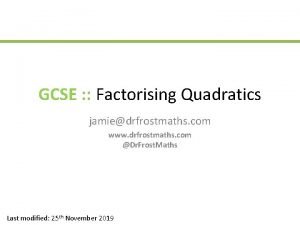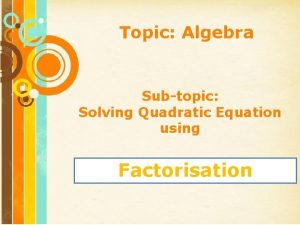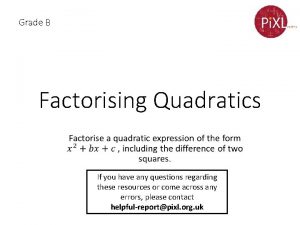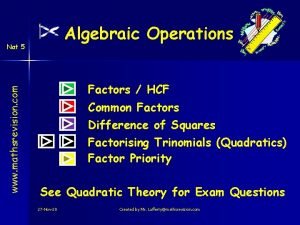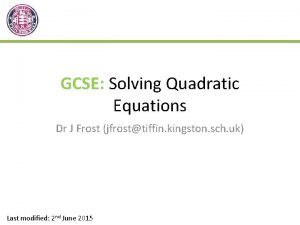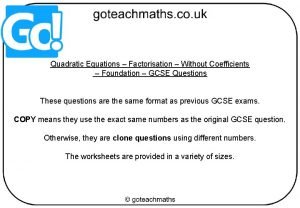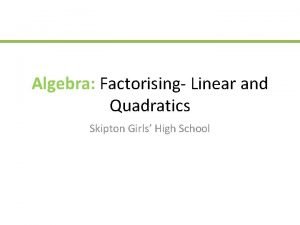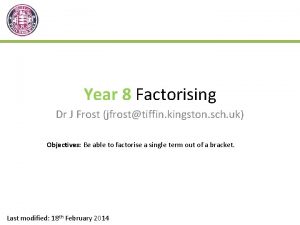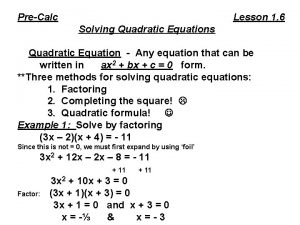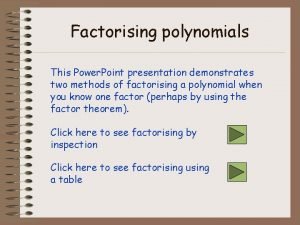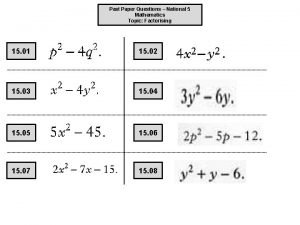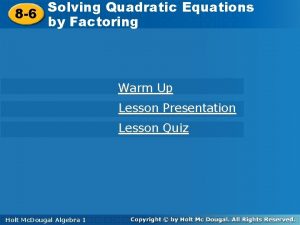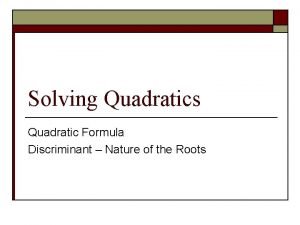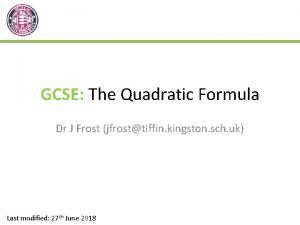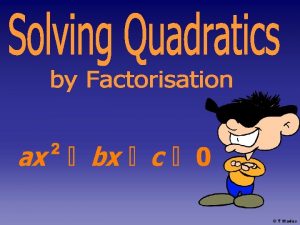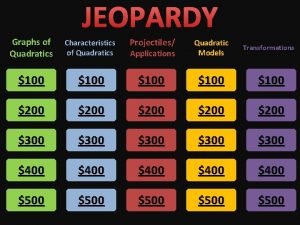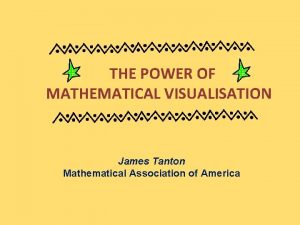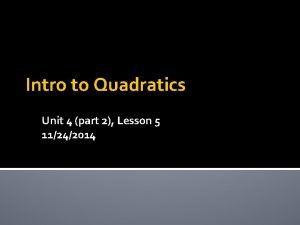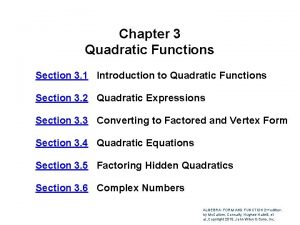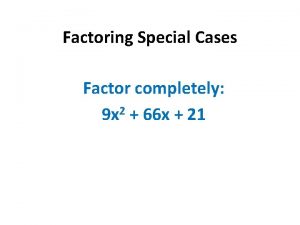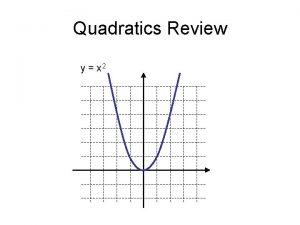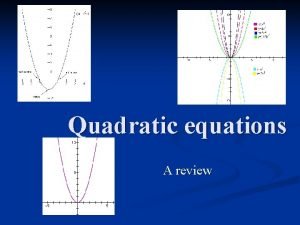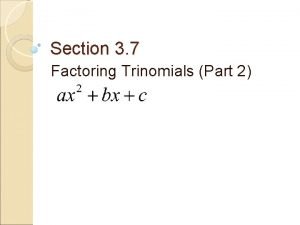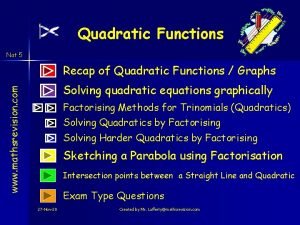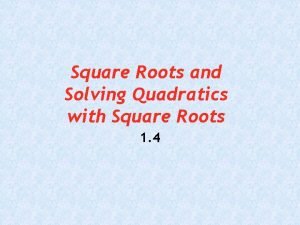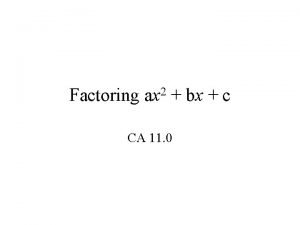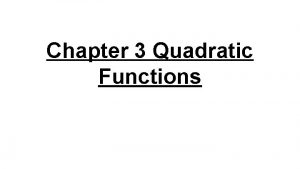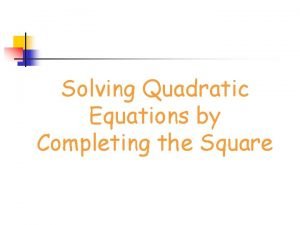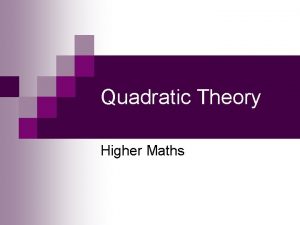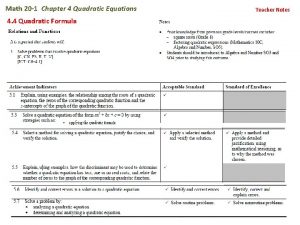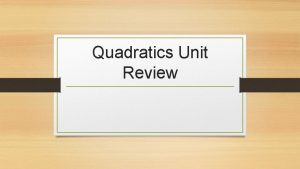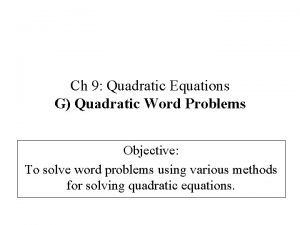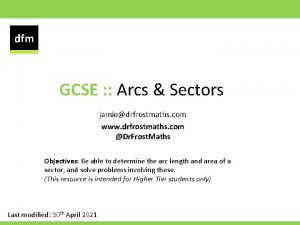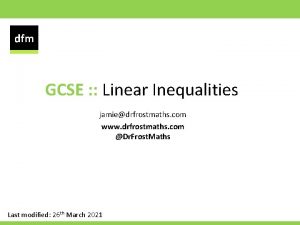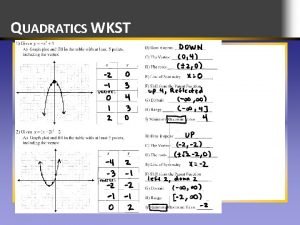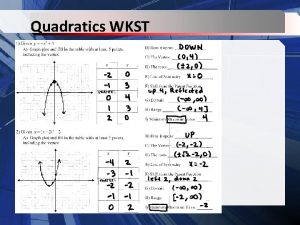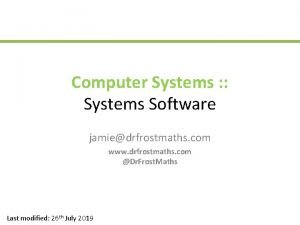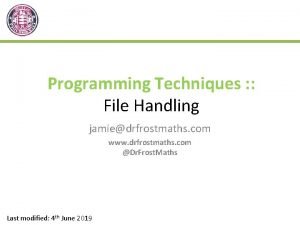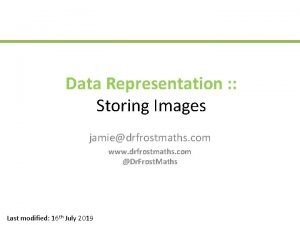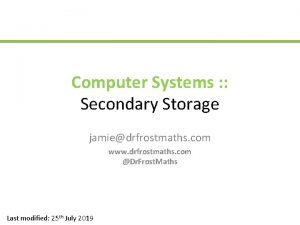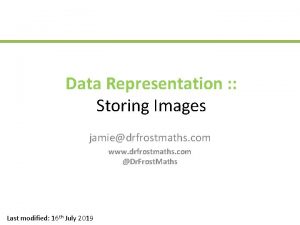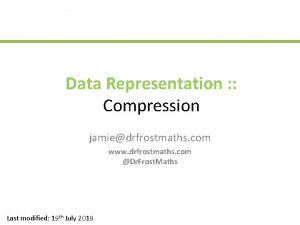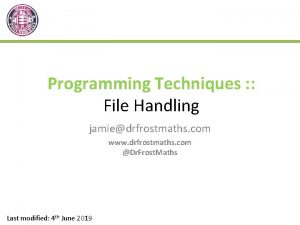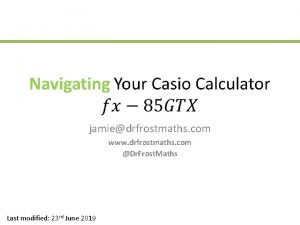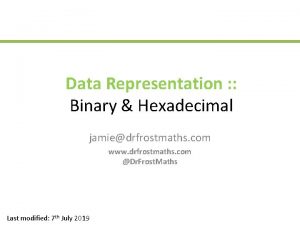GCSE Factorising Quadratics jamiedrfrostmaths com www drfrostmaths com











































- Slides: 43

GCSE : : Factorising Quadratics jamie@drfrostmaths. com www. drfrostmaths. com @Dr. Frost. Maths Last modified: 25 th November 2019

www. drfrostmaths. com Everything is completely free. Why not register? Register now to interactively practise questions on this topic, including past paper questions and extension questions (including MAT + UKMT). Teachers: you can create student accounts (or students can register themselves), to set work, monitor progress and even create worksheets. With questions by: Dashboard with points, trophies, notifications and student progress. Questions organised by topic, difficulty and past paper. Teaching videos with topic tests to check understanding.

Factorising Overview Algebraic factorising means : To turn an expression into a product of expressions. ? ? Single-Bracket Factorisation Factorise Double-Bracket Factorisation A Level Factorisation Factorise Factorising is useful because it enables us to solve harder equations. You will cover this separately in “Solving Quadratic Equations”.

RECAP : : Identifying a Common Factor When factorising expressions, always first look for a common factor to all the terms: Factorise

Further Example Factorise

Quickfire Questions

Exercise 1 a 1 2 3 4 5 6 7 8 9 10 ? ? ? 14 ? ? ? 11 12 15 ? ? 16 ? ? ? N ? 13 ? ?

Factorising out a common bracket Sometimes the common factor might be an entire bracket! The principle remains the same… Exam Note: This skill more typically appears in AQA Further Maths papers, but has been seen in the standard GCSE.

Further Example

Test Your Understanding AQA Further Maths June 2012 Paper 1 ? ?

Exercise 1 b 1 5 ? 2 ? 6 ? ? 3 ? 4 ?

Seven different types of factorisation 1. Factoring out a single term ? on less s ’ y a Tod his! t e n o e’ve d W 3. Difference of two squares 5. Combining techniques EXTENSION: 6. “Pairwise” EXTENSION: 7. Intelligent Guesswork

STARTER : : Patterns when expanding brackets i. e. How could we get these numbers instantly from the 2 and the 3 in the brackets? ? The third term (the constant term) is the product of the numbers in the two brackets.

? ? 30 1 15 2 10 3 6 5 Fro Tip: Think of the factor pairs of 30. You want a pair where the sum or difference of the two numbers is the middle number (11).

Further Examples Recall that we need to find two numbers that add to give -2 and multiply to give -24. Writing these symbols may be a helpful visual reminder. You’re welcome to factorise mentally, but some students find it helpful to write out the factor pairs of the last number first. Find the pair where the sum or the difference is the middle number (-2). 1 24 2 12 3 8 4 6 4 and 6 looks promising, as they differ by 2. But they need to multiply to give negative 24, so one of the numbers must be negative. Out of -4 and 6, or 4 and -6, which add to give -2?

Test Your Understanding ? 1 2 3 4 ? 5 ? ? ?

Exercise 2 1 2 3 ? ? ? 6 7 8 9 10 11 Killers N 2 N 3 13 ? ? ? ? ? ? 5 N 1 12 14 15 ? ? N 4 N 5 ? ? ?

Seven different types of factorisation 1. Factoring out a single term ? ? is! his! t e n o e’ve d e th n o d e We’v W 3. Difference of two squares sson ’s le y a d o T 5. Combining techniques EXTENSION: 6. “Pairwise” EXTENSION: 7. Intelligent Guesswork

TYPE 3: Difference of two squares Firstly, what is the square root of: ? ? ?

TYPE 3: Difference of two squares We have ‘the difference of two squares’ when, unsurprisingly, we have two ‘square’ terms, and the difference between them! Always start with two brackets, one with a +, one with a – Click to Start Fromanimation

Quickfire Examples ? ? ?

Test Your Understanding Factorise: ? ?

Extension : : Challenge Questions ? ? ? ?

Exercise 3 1 ? ? 2 N 4 3 ? 4 5 6 ? 7 8 9 ? ? ? N 5 ? ? N 1 ? ? N 2 N 3 ? ? ?

Seven different types of factorisation 1. Factoring out a single term ? ? is! his! t e n o e’ve d e th n o d e We’v W 3. Difference of two squares ? 5. Combining techniques ! s i e th sson n e do v ’ e W ’s le y a d o T EXTENSION: 6. “Pairwise” EXTENSION: 7. Intelligent Guesswork

Factorise using: b. Splitting the middle term a. ‘Going commando’* Again, need two numbers which add to give two numbers. Essentially ‘intelligent guessing’ of the two brackets, by considering what your guess would expand to. We use these two ? ? ? ? Unlike before, we want two numbers which multiply to give the first times the last numbers (3 and -2) to ‘split the middle term’. Everything else remains the same. Factorise first and second half separately. How could we get the -3? * Not official mathematical terminology.

Further Example 60 1 30 2 20 3 This looks good as difference of 20 and 3 is 17. Numbers are 20 and -3.

One Final Example 36 1 18 2 12 3

Test Your Understanding ? ? For this one splitting the middle term is difficult! Use ‘intelligent guessing’ of the two brackets. ?

Exercise 4 1 2 3 4 5 6 7 8 ? ? ? ? 9 10 11 N 1 N 2 ? ? ?

Seven different types of factorisation 1. Factoring out a single term ? ? is! his! t e n o e’ve d e th n o d e We’v W 3. Difference of two squares ? 5. Combining techniques ? ! s i e th n e do v ’ e W his! et n o d ’ve We sson ’s le y a d o T EXTENSION: 6. “Pairwise” EXTENSION: 7. Intelligent Guesswork

Combining Factorisation Techniques In harder questions, particularly in the AQA IGCSE Further Maths course, you may have to factorise multiple times or combine different factorisation methods. Key Skill: Always look for a common factor first. ? We have the difference of two squares! ? ?

Test Your Understanding 1 2 3 ? ? ? Note: It is not possible to factorise the ‘sum of two squares’.

Exercise 5 Factorise the following expressions. 1 2 3 4 5 6 7 8 N ? ? ? ? ?

l e v e l GCSE r t! o n f i o t p i s i s ’ th t d a n o h y T ff be u t s n o i Extens

Method A: Guessing the brackets Method B: Splitting the middle term ? ? Both of these methods can be extended to more general expressions. This method of ‘intelligent guessing’ can be extended to non-quadratic expressions. After we split the middle term, we looked at the expression in two pairs and factorised. I call more general usage of this ‘pairwise factorisation’.

TYPE 5: Intelligent Guessing Just think what brackets would expand to give you expression. Look at each term one by one. It works! This factorisation will become particularly important if you ever cover something called ‘Diophantine Equations’. ?

Test Your Understanding 1 ? ? ? 2 3 N ?

TYPE 6: Pairwise Factorisation We saw earlier with splitting the middle term that we can factorise different parts of the expression separately and hope that a common term emerges. ? ? ? ?

Test Your Understanding 1 ? 2 ? 3 ? Can you split the terms into two blocks, where in each block you can factorise? N ?

Challenge Wall! 1 2 3 4 Instructions: Divide your paper into four. Try and get as far up the wall as possible, then hold up your answers for me to check. Use any method of factorisation. Warning: Pairwise factorisation doesn’t always work. You sometimes have to resort to ‘intelligent guessing’. 4 ? 3 ? 2 ? 1 ?

Exercise 5 Factorise the following using either ‘pairwise factorisation’ or ‘intelligent guessing’. 1 2 3 4 5 6 7 8 9 10 11 12 13 14 ? ? ? ? ? ? N 1 N 2 ? ? ? N 3 N 4 N 5 ? ? ?

Summary For the following expressions, identify which of the following factorisation techniques that we use, out of: (it may be multiple!) 1 2 3 4 5 6 ? ? ? ? ?
 Drfrost maths
Drfrost maths Solve for x.
Solve for x. Barton maths
Barton maths Factorising quadratics
Factorising quadratics Factorising quadratics cross method
Factorising quadratics cross method Dr frost maths completing the square
Dr frost maths completing the square Factorising questions gcse
Factorising questions gcse Bài thơ mẹ đi làm từ sáng sớm
Bài thơ mẹ đi làm từ sáng sớm Cơm
Cơm Opposite of factorisation
Opposite of factorisation Factorising calc
Factorising calc Factorising single brackets worksheet
Factorising single brackets worksheet Expanding and factorising single brackets
Expanding and factorising single brackets Middle term factorisation
Middle term factorisation Dr frost factorising
Dr frost factorising Factorize expression
Factorize expression Mixed factorising worksheet
Mixed factorising worksheet Factorising calc
Factorising calc Factorise by inspection
Factorise by inspection Factorisation question
Factorisation question Factored equation
Factored equation Quadratic formula method
Quadratic formula method Dr frost solving quadratics
Dr frost solving quadratics Quintic formula
Quintic formula Quadratics jeopardy
Quadratics jeopardy 4-2 standard form of a quadratic function form g answer key
4-2 standard form of a quadratic function form g answer key James tanton quadratics
James tanton quadratics Unit 4 part 2
Unit 4 part 2 8-6 solving x2+bx+c=0
8-6 solving x2+bx+c=0 Factor x^2-9
Factor x^2-9 Quadratics review
Quadratics review Quadratic formula review
Quadratic formula review Factoring criss cross method
Factoring criss cross method Graphing jeopardy
Graphing jeopardy X^2-27 factor
X^2-27 factor Solving quadratics with square roots
Solving quadratics with square roots Site:slidetodoc.com
Site:slidetodoc.com Investigating quadratics
Investigating quadratics Completeing the sqaure
Completeing the sqaure Factoring quadratics jeopardy
Factoring quadratics jeopardy Equal roots higher maths
Equal roots higher maths Types of roots in maths
Types of roots in maths Quadratics unit test
Quadratics unit test Word problems on quadratic equation
Word problems on quadratic equation
